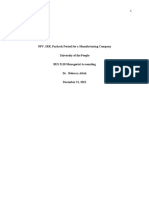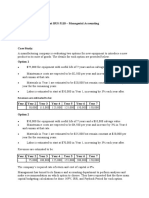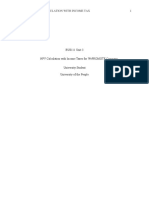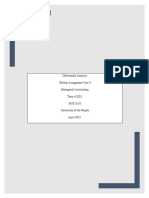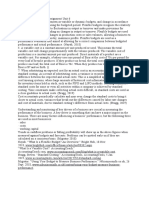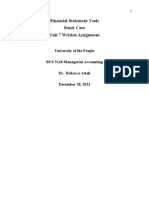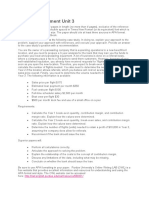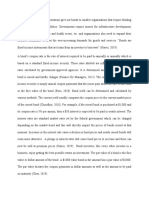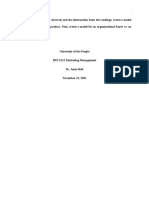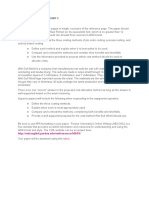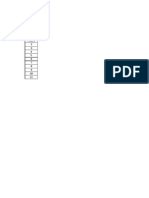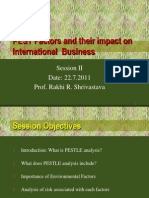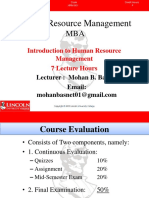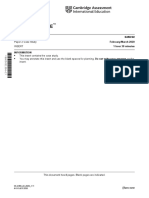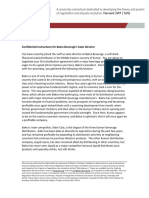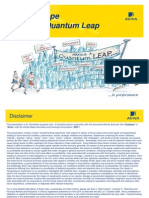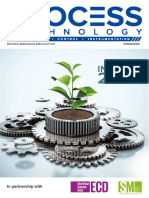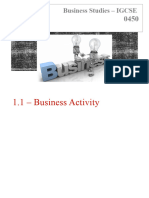Written Assignment Unit 6
BUS 5110: MANAGERIAL ACCOUNTING
Master of Business Administration
BUS 5110 - AY2021-T3
Wednesday, March 10, 2021
Melissa Bartlett (Instructor)
Page 1 of 8
�Case Study
A manufacturing company is evaluating two options for new equipment to introduce a new
product to its suite of goods. The details for each option are provided below
Option 1
• $65,000 for equipment with useful life of 7 years and no salvage value.
• Maintenance costs are expected to be $2,700 per year and increase by 3% in Year 6 and
remain at that rate.
• Materials in Year 1 are estimated to be $15,000 but remain constant at $10,000 per year
for the remaining years.
• Labor is estimated to start at $70,000 in Year 1, increasing by 3% each year after
Revenues are estimated as below
Year 1 Year 2 Year 3 Year 4 Year 5 Year 6 Year 7
- 75,000 100,000 125,000 150,000 150,000 150,000
Computation of Net cash flow: Net cash flow is a profitability system of measurement that
represents the amount of money produced or lost by a business during a given period. It is
calculated by working out the difference between business's cash inflows and cash outflows.
Year 1 2 3 4 5 6 7
Annual Revenue 75,000.00 100,000.00 125,000.00 150,000.00 150,000.00 150,000.00
Less: Maintenance
Cost 2700 2,700.00 2,700.00 2,700.00 2,700.00 2,781.00 2,781.00
Page 2 of 8
� Less: Material
Expenses 15000 10,000.00 10,000.00 10,000.00 10,000.00 10,000.00 10,000.00
Labor 70000 72,100.00 74,263.00 76,491.00 78,785.00 81,149.00 83,584.00
(87,700.00) (9,800.00) 13,037.00 35,809.00 58,515.00 56,070.00 53,635.00
Computation of IRR: The internal rate of return is a metric used in financial analysis to
estimate the profitability of potential investments. The internal rate of return is a discount
rate that makes the net present value (NPV) of all cash flows equal to zero in a discounted cash
flow analysis. IRR calculations rely on the same formula as NPV does (Fernando, 2021).
Year Net Cash Flow
Year 0 (65,000.00)
Year 1 (87,700.00)
Year 2 (9,800.00)
Year 3 13,037.00
Year 4 35,809.00
Year 5 58,514.00
Year 6 56,070.00
Year 7 53,635.00
IRR =IRR(O19:O26)
IRR VALUE 6%
Computation of Npv: It is calculated by taking the difference between the present value of cash
inflows and present value of cash outflows over a period of time. As the name suggests, net
present value is nothing but net off of the present value of cash inflows and outflows by
discounting the flows at a specified rate.
Year Amount
Page 3 of 8
� Year 0 (65,000.00)
Year 1 (87,700.00)
Year 2 (9,800.00)
Year 3 13,037.00
Year 4 35,809.00
Year 5 58,515.00
Year 6 56,070.00
Year 7 53,635.00
Rate of Return 8%
NPV (11,482.31)
ARR= Average Net Profit ÷ Initial Investment
= 17081 ÷ 0.2627
Average Profit= Sum of Inflow ÷ 7
=119566 ÷ 7= 17080.9
Calculation of Payback: The payback period is calculated by dividing the amount of the
investment by the annual cash flow (Kagan, 2020).
Year Amount Cumulative Amount
0 (65,000.00) (65,000.00)
1 (87,700.00) (152,700.00)
2 (9,800.00) (162,500.00)
3 13,037.00 (149,463.00)
4 35,809.00 (113,654.00)
5 58,515.00 (55,139.00)
6 56,070.00 931.00
7 53,635.00 54,566.00
Cumulative amount is calculated by adding preceding amount for each year.
Page 4 of 8
�Payback Period= Year 5 + 55139 ÷ 56070
=5 + 0.9834 = 5.98 Years
Option- 2
• $85,000 for equipment with useful life of 7 years and a $13,000 salvage value
• Maintenance costs are expected to be $3,500 per year and increase by 3% in Year 6 and
remain at that rate.
• Materials in Year 1 are estimated to be $20,000 but remain constant at $15,000 per year
for the remaining years.
• Labor is estimated to start at $60,000 in Year 1, increasing by 3% each year after.
Revenues are estimated to be:
Year 1 Year 2 Year 3 Year 4 Year 5 Year 6 Year 7
- 80,000 95,000 130,000 140,000 150,000 160,000
Computation of Net Cash Flow
Year 1 Year 2 Year 3 Year 4 Year 5 Year 6 Year 7
Annual
Revenue - 80,000.00 95,000.00 130,000.00 140,000.00 150,000.00 160,000.00
Less:
Maintenance
Cost (3,500.00) (3,500.00) (3,500.00) (3,500.00) (3,500.00) (3,605.00) (3,605.00)
Less: Material
Expenses (20,000.00) (15,000.00) (15,000.00) (15,000.00) (15,000.00) (15,000.00) (15,000.00)
Labor (60,000.00) (61,800.00) (63,654.00) (65,563.00) 67,530.00 (69,556.00) (71,643.00)
Page 5 of 8
� (83,500.00) (300.00) 12,846.00 45,936.00 53,969.00 61,839.00 82,752.00
Computation of NPV
Year Amount
0 (85,000.00)
1 (83,500.00)
2 (300.00)
3 12,846.00
4 45,937.00
5 53,970.00
6 61,839.00
7 82,752.00
Rate Of Return 8%
IRR 5,375.75
Computation of IRR
Year Amount
-
1 (85,000.00)
2 (83,500.00)
3 (300.00)
4 12,846.00
5 45,937.00
6 53,970.00
7 61,839.00
8 82,752.00
IRR Formula 9%
Calculation of Payback
Page 6 of 8
� Year Amount Cumulative
- (85,000.00) (85,000.00)
1.00 (83,500.00) (168,500.00)
2.00 (300.00) (168,800.00)
3.00 12,846.00 (155,954.00)
4.00 45,937.00 (110,017.00)
5.00 53,970.00 (56,047.00)
6.00 61,839.00 5,792.00
7.00 82,752.00 88,544.00
Payback Period= Year 5 + 56047 ÷ 61839
= 5 + 0.90634= 5.09 Years.
Average Profit= Sum of Inflow ÷ 7
= 173544 ÷ 7= 24,792
Option 2 has the highest NPV. IRR is the rate of return at which NPV of the project is ZERO.
Page 7 of 8
�References.
Fernando, J. (2021, March 4). Internal Rate of Return (IRR). Investopedia.
https://www.investopedia.com/terms/i/irr.asp.
Kagan, J. (2020, August 29). Payback Period Definition. Investopedia.
https://www.investopedia.com/terms/p/paybackperiod.asp.
Page 8 of 8









